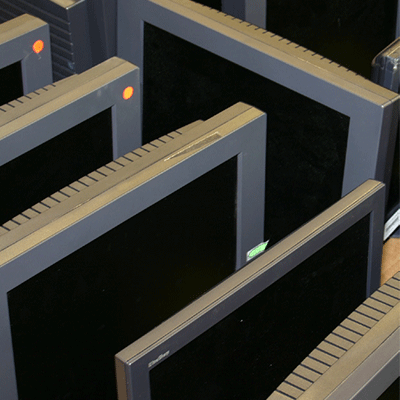 Slim, stylish, energy-efficient and unconstrained by the size and weight limitations of older display technologies, flat-panel displays have proven irresistible to consumers and manufacturers. These qualities have made flat-panel displays ideal for use in laptop and desktop computers, televisions, mobile devices, medical instruments and industrial equipment.
Slim, stylish, energy-efficient and unconstrained by the size and weight limitations of older display technologies, flat-panel displays have proven irresistible to consumers and manufacturers. These qualities have made flat-panel displays ideal for use in laptop and desktop computers, televisions, mobile devices, medical instruments and industrial equipment.
The shift from cathode ray tube (CRT) to flat-panel displays, which includes liquid crystal displays (LCDs) and plasma displays, has proven to be the most significant development in television and monitor equipment in the last decade.
A mandated switch to digital TV broadcasting in 2009, the inability of CRT TVs to deliver a movie theater-like viewing experience, and the introduction of Internet-connected TVs that deliver interactive viewer content have hastened the move to flat-panel displays.
In fact, NPD DisplaySearch analysts acknowledge that LCD TVs continue to be the primary TV type shipped worldwide—accounting for about 84 percent of all TV shipments in 2011—and total LCD TV shipments are anticipated to reach 270 million units by 2014.
Smaller Footprint
Beyond the delivery of a high-definition, interactive and theater-like viewing experience, a report conducted by Pike Research last year on behalf of the Consumer Electronics Association (CEA) revealed flat-panel displays also deliver several environmental advantages.
The study, Materials Footprint Reduction of Televisions and Computer Monitors: 2004-2010, found that these lighter and smaller TVs and monitors reduce the amount of resources required to manufacture the devices, cut the amount of materials needed for packaging and lower the amount of fuel used to transport them.
An old 36-inch CRT TV generated about the same amountof electronic waste as 5,080 cell phones, according to the CEA report. A 70-inch flat-panel TV, by comparison, produces the waste equivalent to 953 cell phones and a 30-inch flat-panel computer monitor creates the waste comparable to 211 cell phones.
Tear Down Trouble
However, the reduced materials footprint of flat-panel displays does not tell the whole environmental story. Flat-panel displays contain glass, plastics and metals and other materials, which when properly recycled conserve natural resources by reducing the need to mine and manufacture new materials.
The problem? Older LCD displays contain mercury-filled cold cathode fluorescent lamps (CCFLs) to backlight the LCD panels. The bulbs are cost-effective and energy-efficient,but fragile, and the mercury makes it necessary to remove them before additional processing and shredding to avoid exposing workers to toxic dust or vapors.
But most flat-panel devices are not manufactured for easy disassembly. The fasteners of a typical flat-panel display are small, often inaccessible, and include clips, screws and glues. The location of these fasteners, along with other components, varies among manufacturers.
These numerous design variations and component configurations have made it difficult for recyclers to develop an efficient and standardized disassembly process.
New Display Technologies
Flat-panel displays will likely become safer and easier to process with the wider adoption of new technologies, such as light-emitting diodes (LEDs) and organic light-emitting diodes (OLEDs). LEDs are replacing CCFLs. This eliminates the risk of mercury contamination. OLEDs are starting to replace LCDs. OLEDs require fewer materials and offer simpler construction. While OLEDs are thinner and lighter than LCDs and use less power than conventional flat-panel displays, they remain expensive.
“The EPA estimates that CRT TVs and monitors still account for nearly half of all electronics ready for end-of-life-management; however, the rapid and widespread adoption of flat-panel display technology will eventually make these devices one of the fastest-growing sources of electronic waste,” said Steve Skurnac, President, Sims Recycling Solutions, Americas. “As electronics evolve so do the materials used in manufacturing them, which means our recycling processes will evolve as well so we can continue to recycle these devices in the safest, most environmentally responsible and cost-efficient method possible.”
